Editor’s Key Takeaways: Mastering Cherry Blossom Photography: Ultimate Guide Highlights

Here is a summary of the blog post:
- Introduction: Photography lovers often seek to capture the stunning beauty of cherry blossoms. This guide provides essential tips and tricks for doing these flowers justice.
- Where to Find Cherry Blossoms: Cherry blossoms, known as sakura in Japan, can also be found in certain parks across the USA. These trees bloom seasonally, peaking in March and April.
- Camera Settings and Equipment: Recommendations for optimal setups and tools to capture the fine details of cherry blossoms.
- Photography in Nature: Tips for capturing cherry blossoms in their natural habitats, emphasizing lighting and composition.
- Portrait and Special Session Tips: Guidance for using cherry blossoms as backdrops for portrait photography, maternity sessions, engagement photos, and family photoshoots.
- Photography Ideas: Creative concepts to make cherry blossom photos stand out.
- Significance of Cherry Blossoms: The cultural importance of cherry blossoms, symbolizing spring, life’s fleeting moments, and the acceptance of destiny.
- Famous Locations: Renowned cherry blossom sites in the USA, such as San Francisco’s Golden Gate Park Japanese Tea Garden.
By following these tips and understanding the symbolic weight of cherry blossoms, photographers can capture breathtaking and meaningful images.
When you buy through links on our site, we may earn a commission at no cost to you. We evaluate products independently. Commissions do not affect our evaluations. As an Amazon Associate, we earn from qualifying purchases.
Introduction
Photography is a great way to capture natural beauty, and cherry blossoms make for stunning subjects! But while cherry blossoms are a popular subject choice, not everyone is able to capture the flowers at their finest.
Here is our guide to cherry blossom photography, which includes plenty of tips and tricks to help you do these plants justice!
Cherry Blossom Photography Tips:
The Significance of Cherry Blossoms
Cherry blossoms are more than just beautiful trees; they have great cultural significance. As artists, it’s important to understand the meaning of our subjects and to treat them with respect.
Known as sakura in Japan, cherry blossoms refer to the beautiful pink blooming flower on trees in the Prunus genus. Cherries are beautiful ornamental trees, loved for their intense color and stunning appearance.
Cherry blossoms symbolize spring and are a metaphor for the ephemeral nature of life, the acceptance of destiny, and mortality. These flowers only bloom for a short period of time before wilting away.
Keeping these ideas in mind can help you create (and appreciate) incredible cherry blossom photos.
Where to Find Cherry Blossoms

Although cherry blossoms can be easily found in Japan and other countries, in the United States, they tend to be more localized. Cherry blossom trees are not native to the USA; instead, they’re planted for beautiful displays in a very specific fashion. Do remember that cherry trees are seasonal bloomers, and you will only be able to see them in the spring, with peak blooms in March and April.
Famous Cherry Blossom Destinations
Some of the more iconic cherry tree locations in the United States include:
- San Francisco, California: The Golden Gate Park Japanese Tea Garden
- Los Angeles, California: The Descanso Gardens
- San Diego, California: Balboa Park
- Portland, Oregon: Tom McCall Waterfront Park and the Portland Japanese Garden
- Seattle, Washington: The University of Washington Quad
- Dallas, Texas: The Arboretum
- Nashville, Tennessee: Cherry Blossom Park
- Chicago, Illinois: The Chicago Botanic Garden
- Washington, D.C.: The National Mall
- Philadelphia, Pennsylvania: Fairmount Park
- Brooklyn, New York: The Brooklyn Botanic Garden
- Boston, Massachusetts: The Charles River Esplanade
- Newark, New Jersey: Branch Brook Park
- Athens, Ohio: Ohio University
- Traverse City, Michigan: Highway M-37
- St. Louis, Missouri: The Missouri Botanical Garden
- Newark, Ohio: The Dawes Arboretum
- Delray Beach, Florida: The Morikami Museum and Japanese Gardens
Some of the most iconic global destinations include:
- Hirosaki, Japan: The Hirosaki Festival
- Kyoto, Japan: Philosopher’s Path
- Meghalaya, India: The India Cherry Blossom Festival
- Copenhagen, Denmark: The Copenhagen Sakura Festival
- Paris, France: Trocadéro
- Vancouver and Victoria, British Columbia: The VanDusen Botanical Garden
- Dublin, Ireland: Trinity College Dublin
- Bonn, Germany: The Tree Tunnels
- Jerte Valley, Spain: Primavera y Cerezo en Flor
- Vilnius, Lithuania: Chiune Sugihara Sakura Park
Of course, if you’re looking to do a full photoshoot (with a portrait subject posed among the trees), you will need to contact the locale and inquire about photography rules. Some places require photography permits and others do not.
Camera Settings and Equipment to Consider
Cherry blossoms are striking to the human eye, but the color isn’t always perfectly rendered by our cameras. As such, choosing the right settings and picking the right gear can help bring those pink flowers to life.
Suggested Gear
As cherry blossoms are a stationary daytime subject, the camera itself doesn’t play a hugely significant role. What does matter is the lens!
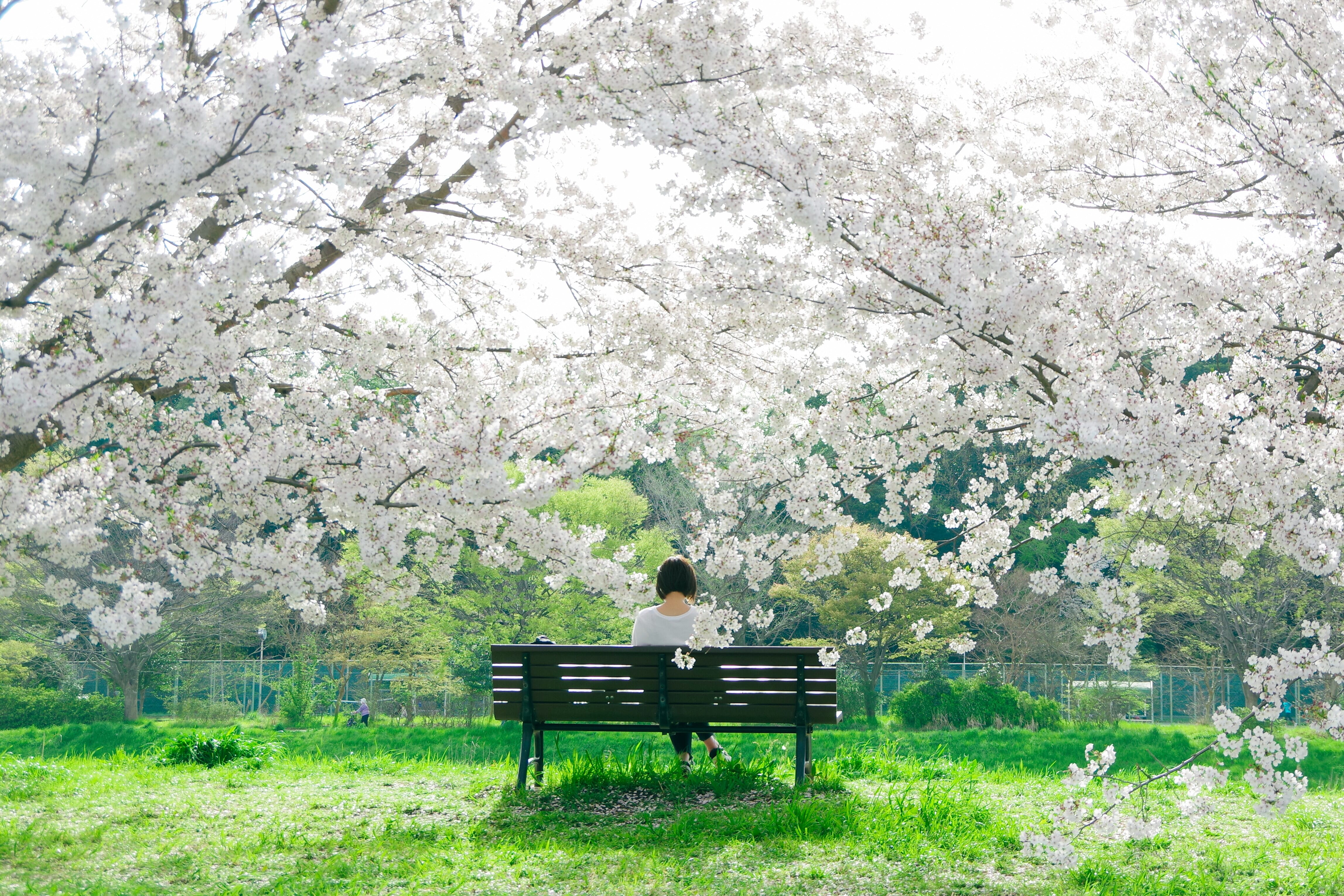
There are many different ways to tackle cherry blossom photography, so I’d recommend you use lenses that offer you lots of versatility. If you’ve trekked all the way out to a cherry blossom field, you should take as many different kinds of photographs as possible!
Therefore, 24-70mm lenses are great choices. These lenses allow you to go from a wide frame of view to a much tighter one, making it easy to shoot both portraits and landscapes.

You ideally want a lens that has a wide maximum aperture so you have the option of shooting with an extremely shallow depth of field. Cherry blossom photography is often done with shallow depth of field effects, because you can focus on just one stunning flower and let the rest melt away into a pastel bokeh.
On the other hand, capturing an entire row of cherry trees can also give you great results, in which case you’ll need to narrow your aperture for a deeper depth of field.
My favorite lens for capturing cherry blossoms is the Sigma 35mm f/1.2 DG DN Art. The 35mm focal length is just wide enough to create beautiful compositions, and being able to switch between ultra-shallow apertures and narrower apertures is a great perk.
Macro lenses are also great for cherry blossom photography; they’ll let you get right up close and capture all the details in a single flower.
Carrying a top-quality ND (neutral density) filter is also a good idea (and I expand on this below!).
Suggested Settings
The ideal cherry blossom settings depend on the type of image you are looking to capture. I do suggest you shoot in Manual mode so that you can adjust the shutter speed, ISO, and aperture independently, but I can’t give you specific instructions.
What I can advise you on is your white balance and metering mode as this should remain fairly consistent regardless of the type of image you are trying to capture.
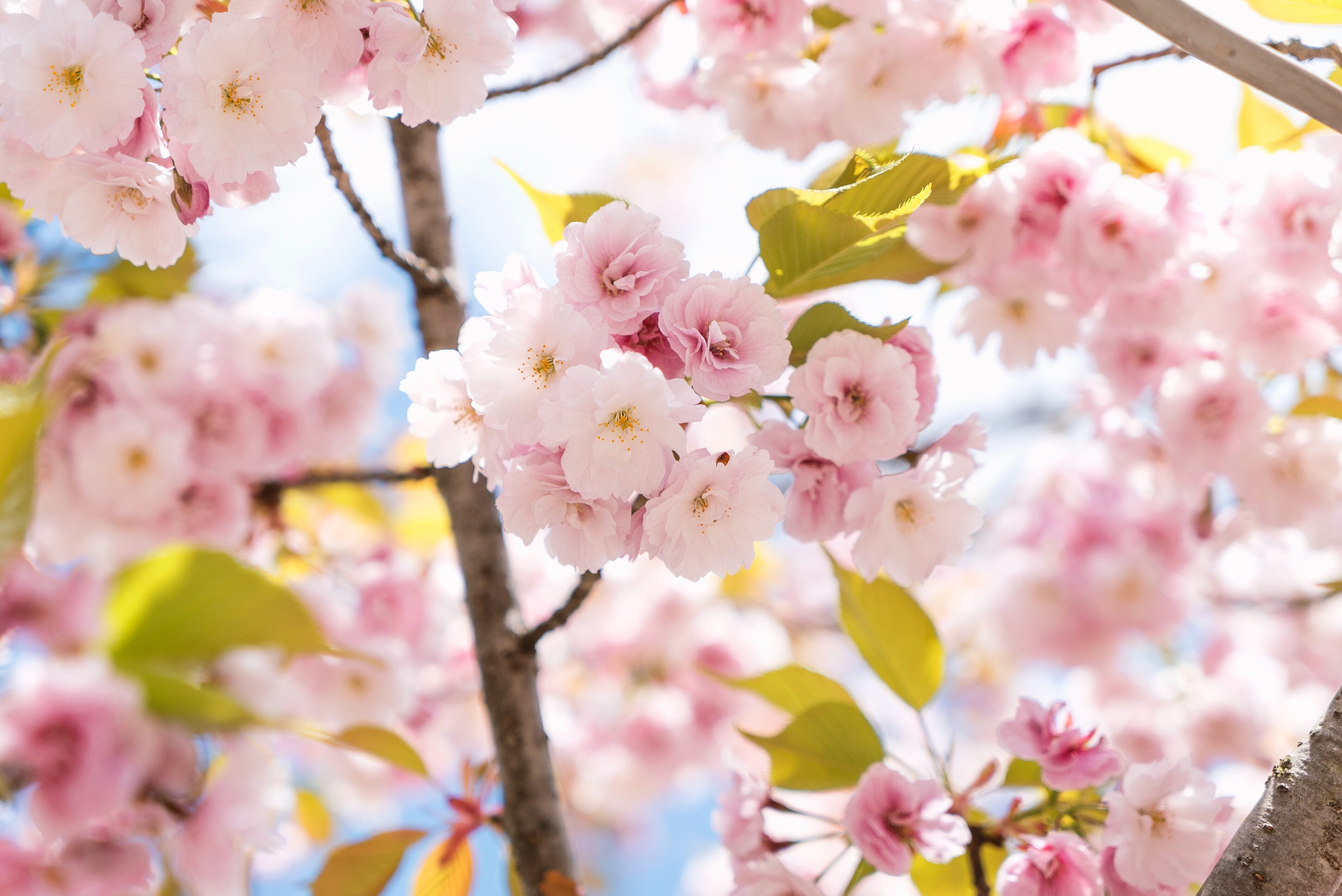
White balance is all about neutralizing unwanted color casts in your images. Cherry blossoms are best known for their pastel pink color, and recording this color correctly is very important.
I recommend setting a custom white balance. That way, you can capture a perfect color based on the lighting you’re facing at that day and time. Each camera sets custom white balances a bit differently, so refer to your user manual for detailed instructions.
Metering modes allow you to specify how your camera handles exposure. By default, cameras tend to be set to Matrix (or Evaluative) metering, which considers all of the lightest and darkest parts of your frame and identifies the exposure accordingly. This is a fantastic mode to use when you are capturing cherry blossoms during a sunset or an overcast day (i.e., when the lighting is more even).
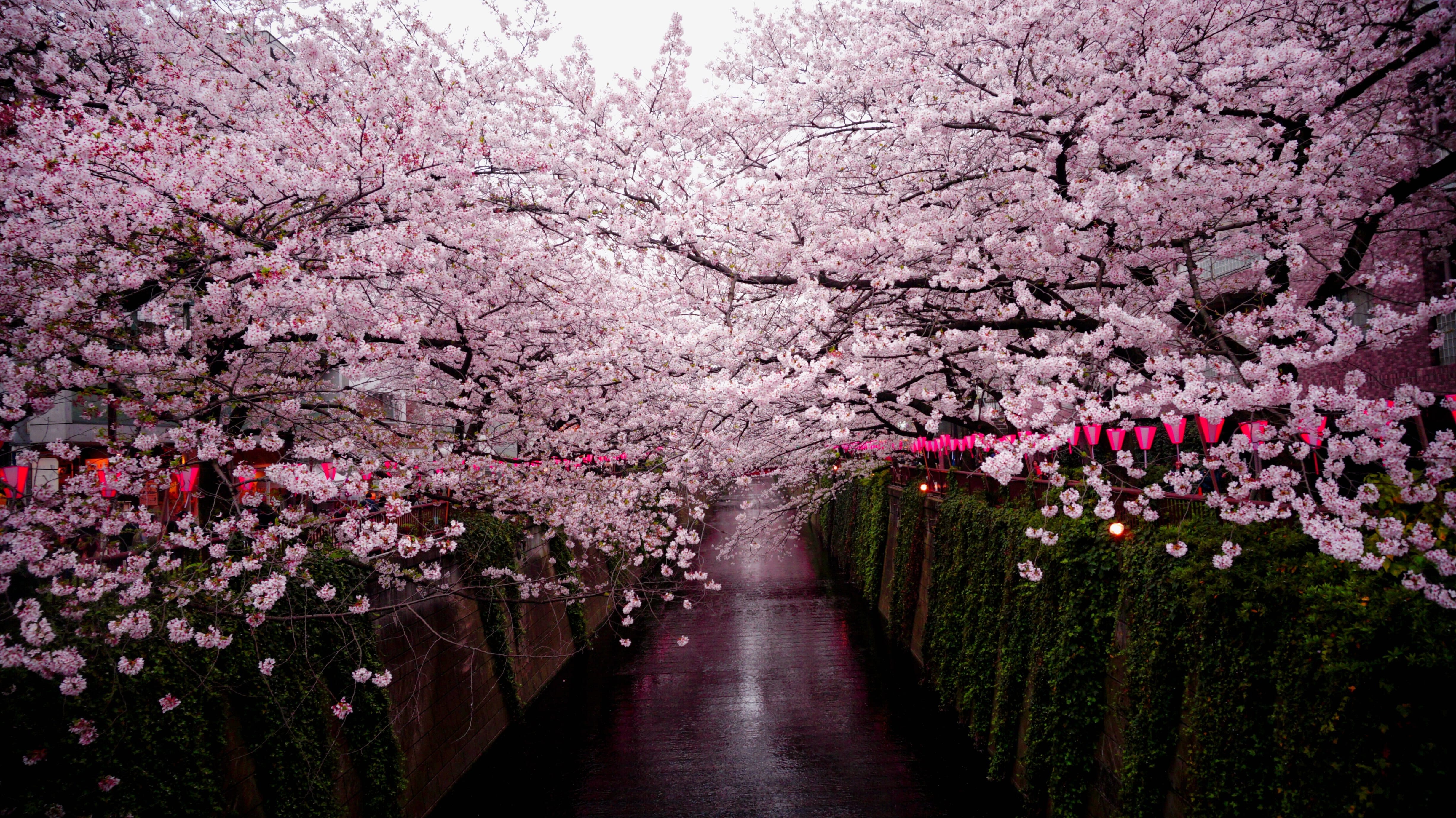
However, if you are capturing images during a high-contrast situation, such as on a bright sunny day or in the morning, you’ll likely want to use Spot metering instead. Spot metering tells your camera to evaluate a small section of your photo (most often the center of the image), and that spot is then used to determine the proper exposure.
Tips for Capturing Cherry Blossoms in Nature Photography
If you’re a nature or landscape photographer aiming to capture the spring bloom, here are some tips just for you:
1. Consider Your Composition

As any landscape or nature photographer will tell you, composition is absolutely vital to the success of an image. Composition refers to the arrangement of elements in a frame, all of which need to work together to produce a great image.
Cherry blossoms tend to create blankets of pink, so be sure to carefully balance your photograph. You don’t want the pink blanket to be overwhelming or for one half of the image to feel heavy in comparison to the other!
When capturing close-ups of the blooms, try placing the flower off-center to create a more dynamic image.
2. Use Depth of Field to Tell a Story
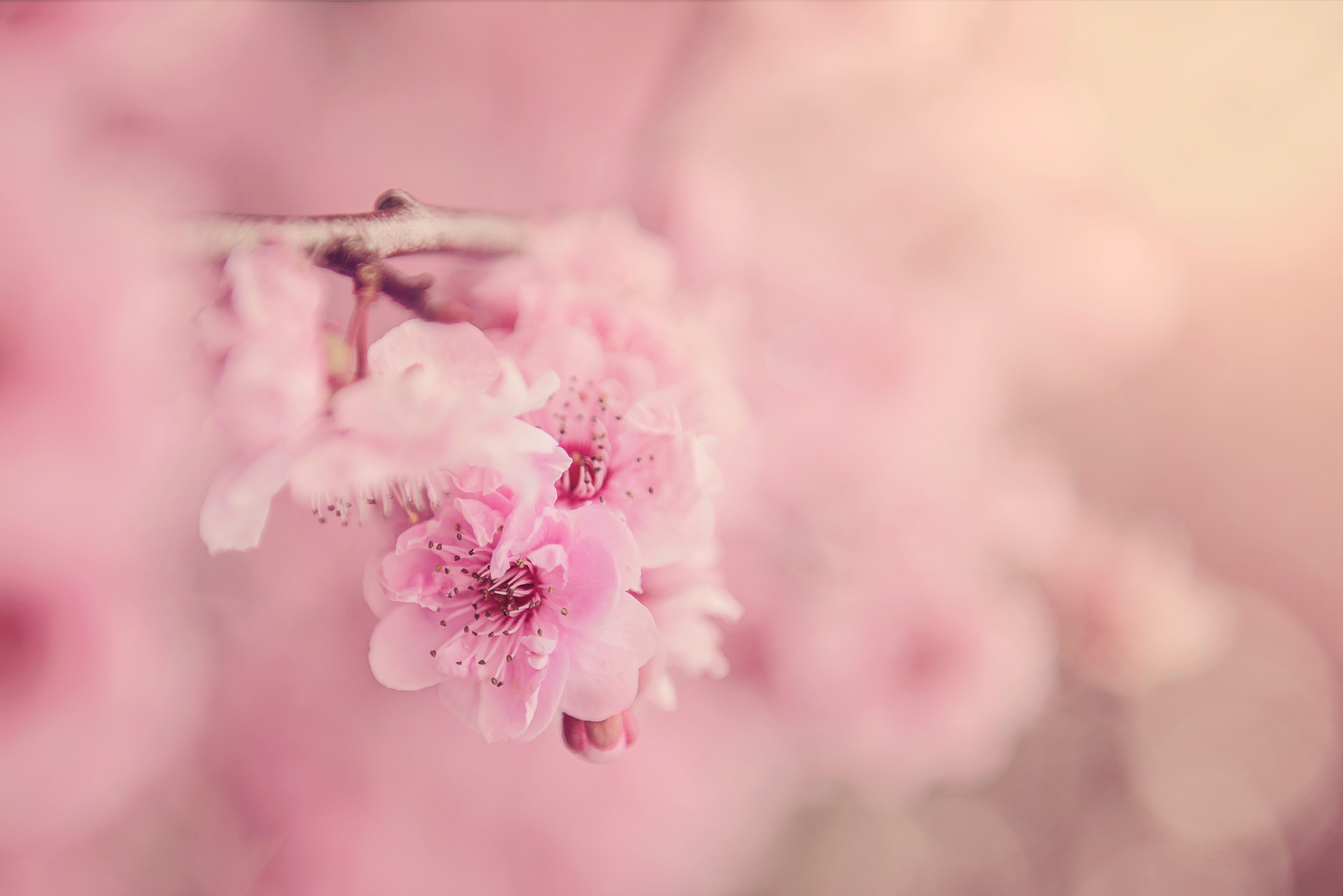
Depth of field is a key compositional aspect to keep in mind when trying to tell the story of your subject. If the surrounding environment is an important part of what you’re looking to express, use apertures from f/9 all the way to f/22 to keep your entire shot in focus.
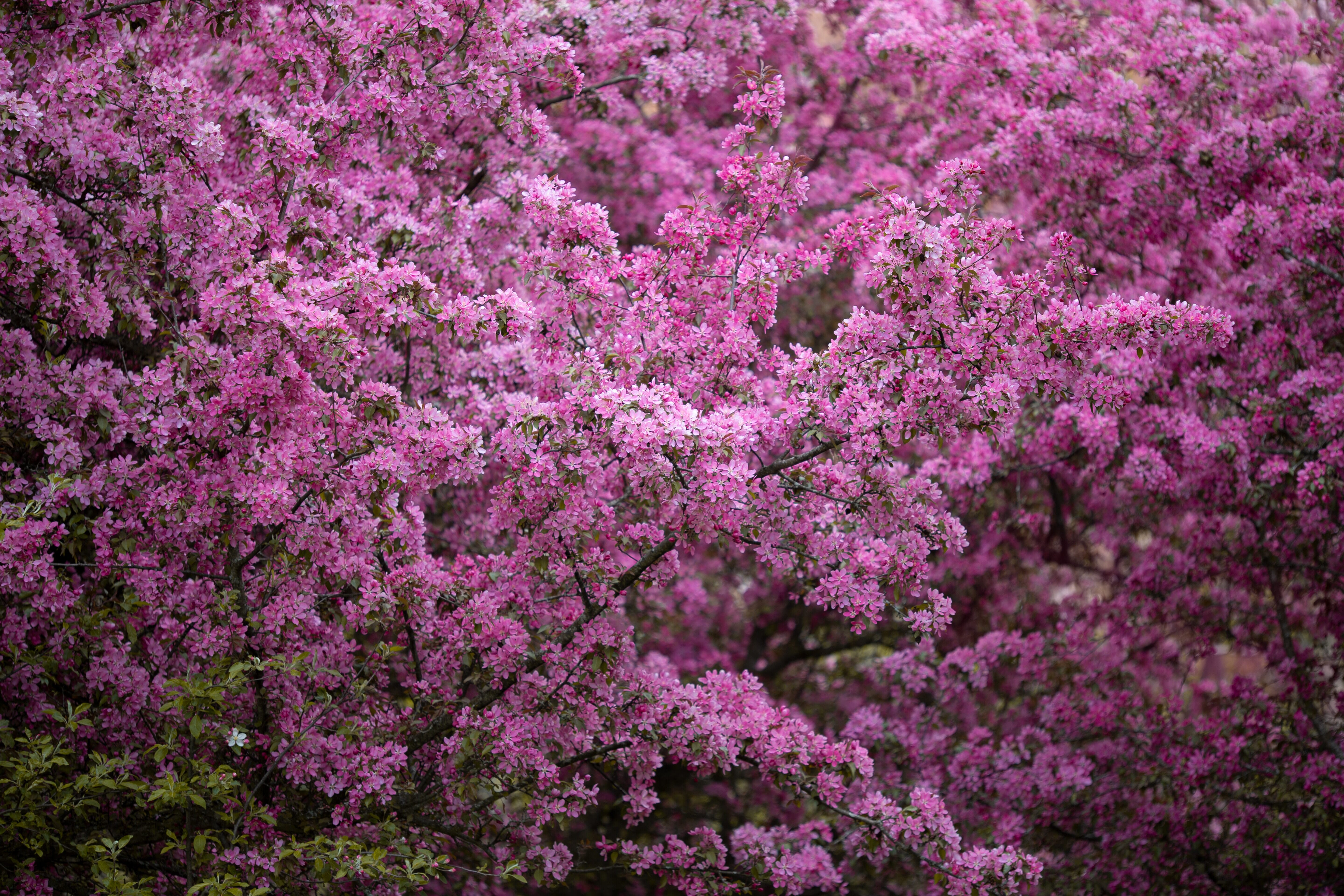
If you want your audience to focus on little details and appreciate the natural design of the flowers, use a shallow depth of field. This ensures the location won’t distract from what you want your viewer to see, feel, and understand. An aperture of f/1.2 through f/2.8 will do this very effectively.
3. Play with Different Vantage Points
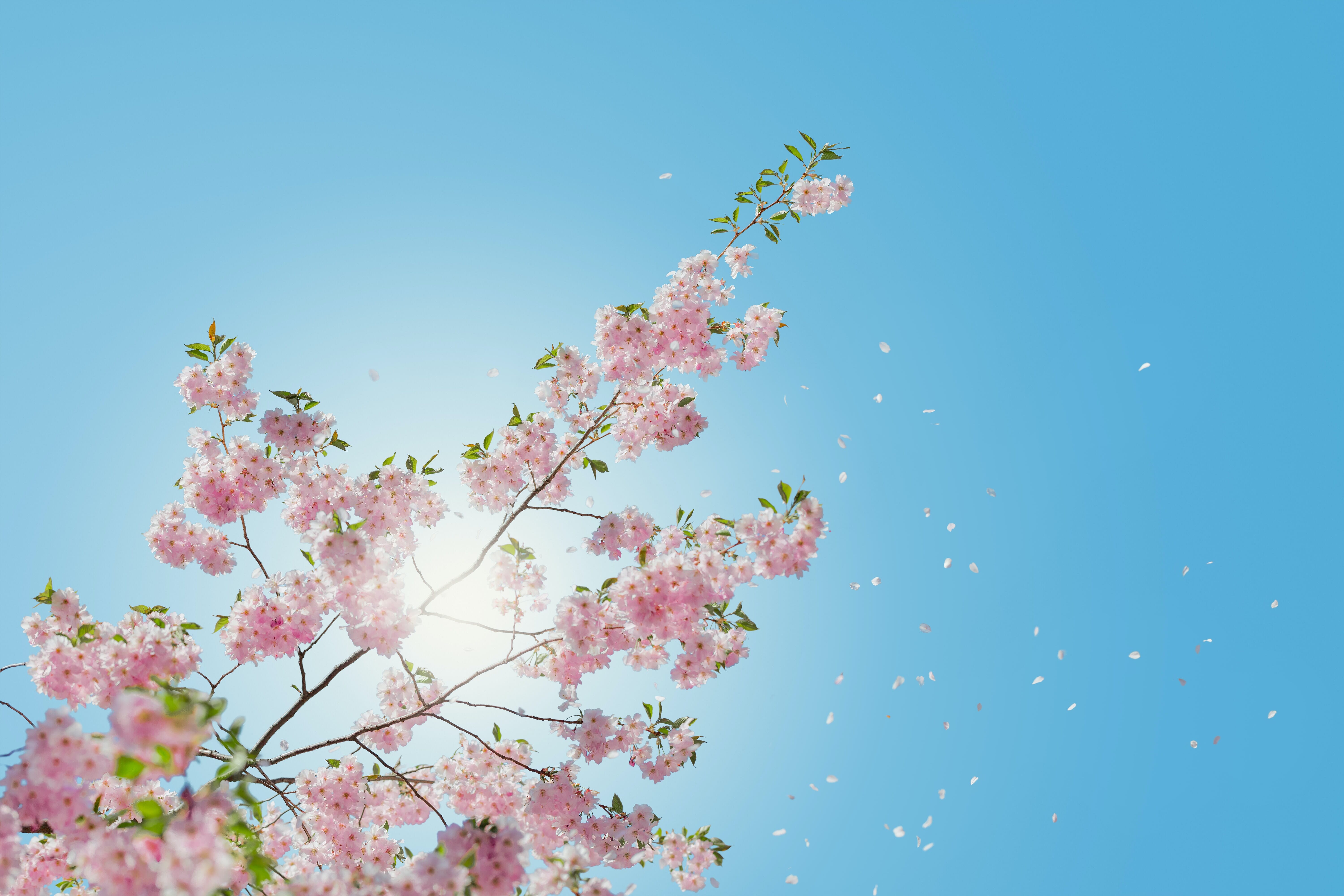
Cherry blossoms are beautiful from many different angles, so why not capture them all? Lie on the ground and shoot up at a blossom tree, climb a hill and shoot down below, or shoot at eye level. Different vantage points offer different ways to tell a story.
Pro tip: Shooting against a blue sky is a popular and effective choice because the colors are so complementary.
4. Shoot High Key and Low Key for Different Moods
High key and low key refer to different lighting styles in photography.

High-key photography is when your subject is captured against a very light background. Your subject should be well exposed, but the background should be significantly brighter! Low-key photography is the opposite; it’s when your subject is captured against a very dark background.

Low-key lighting creates shadows that conceal and reveal details, while high-key lighting reduces or blows out the shadows.
You can create high-key images by capturing blossoms against a bright sky. And you can create low-key, moody images by capturing blossoms against dark water.
5. Use Neutral Density Filters
Neutral density filters, also known as ND filters, screw on the front of your lens and reduce the light that hits your sensor. ND filters are commonly used to capture long exposures or very shallow depth of field effects on bright days.
If you’re shooting in the bright sun but want darker images without sacrificing depth of field, an ND filter is your best friend.
Tips for Capturing Cherry Blossoms in Portrait Photography
Portraits, engagement sessions, and maternity sessions all go great with cherry blossoms! Here are some tips to help you out:
1. Use the Trees as Leading Lines to Your Subject

The many branches of the cherry trees can make great leading lines, which will bring the viewer’s eye to your subject, effectively leading them where you want them to go.
Related Posts
Tree branches have long been used as leading lines, and these pink-flowered branches will certainly work well.
2. The Time of Day Makes a Difference
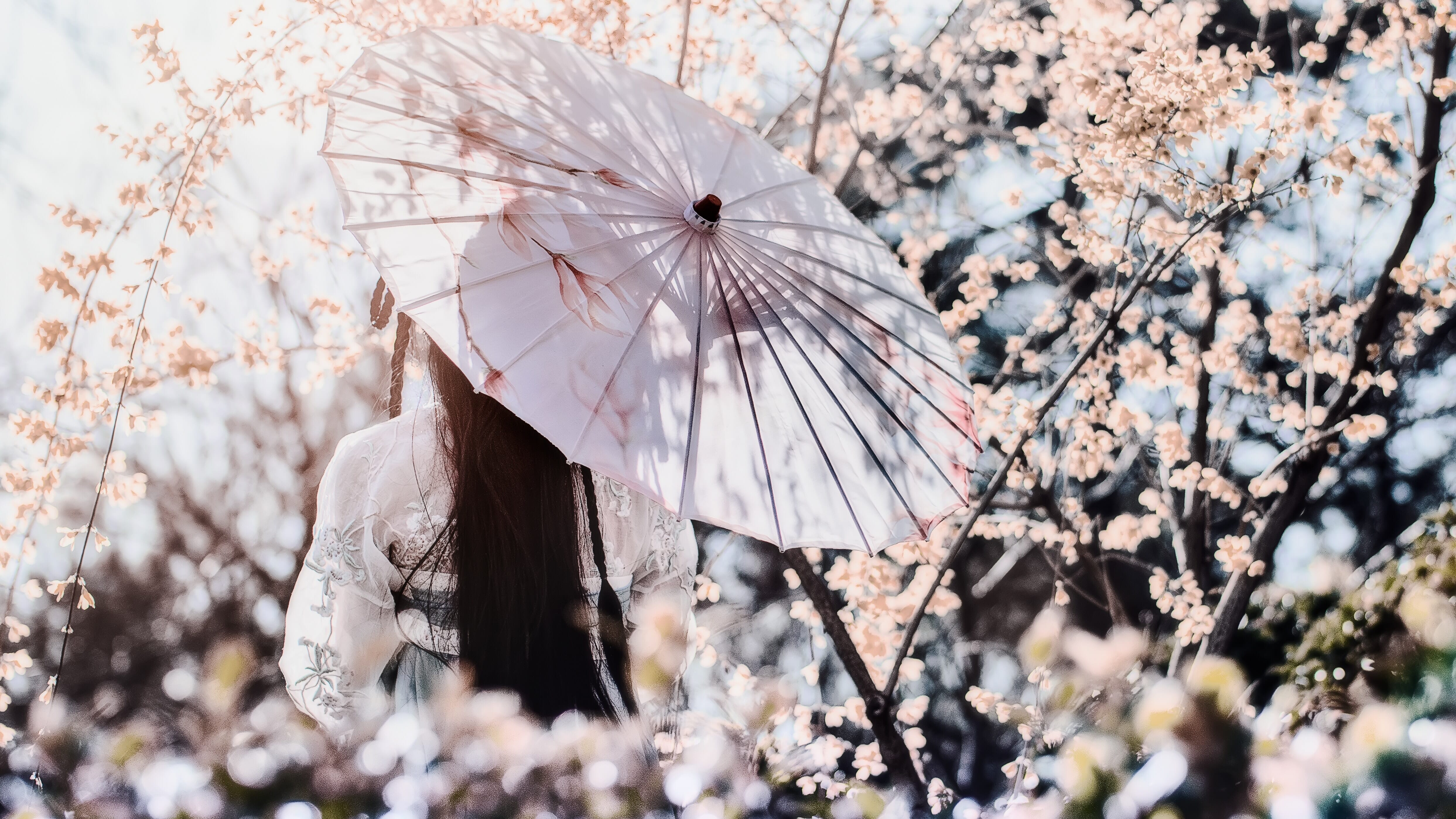
Cherry blossom petals are thin and translucent, so they look very cool under the right light. And if you place a subject under a cherry blossom tree, they may be covered by interesting shadows.
In other words, the time of day will majorly impact how the blossoms and your model appear!
To create striking contrast or to make the blossoms look more white, photograph at a bright time of day (e.g., the late morning hours). For more pastel colors and even skin tones, aim to shoot during the golden hours or on an overcast day.
3. Use Flash for Fill Light
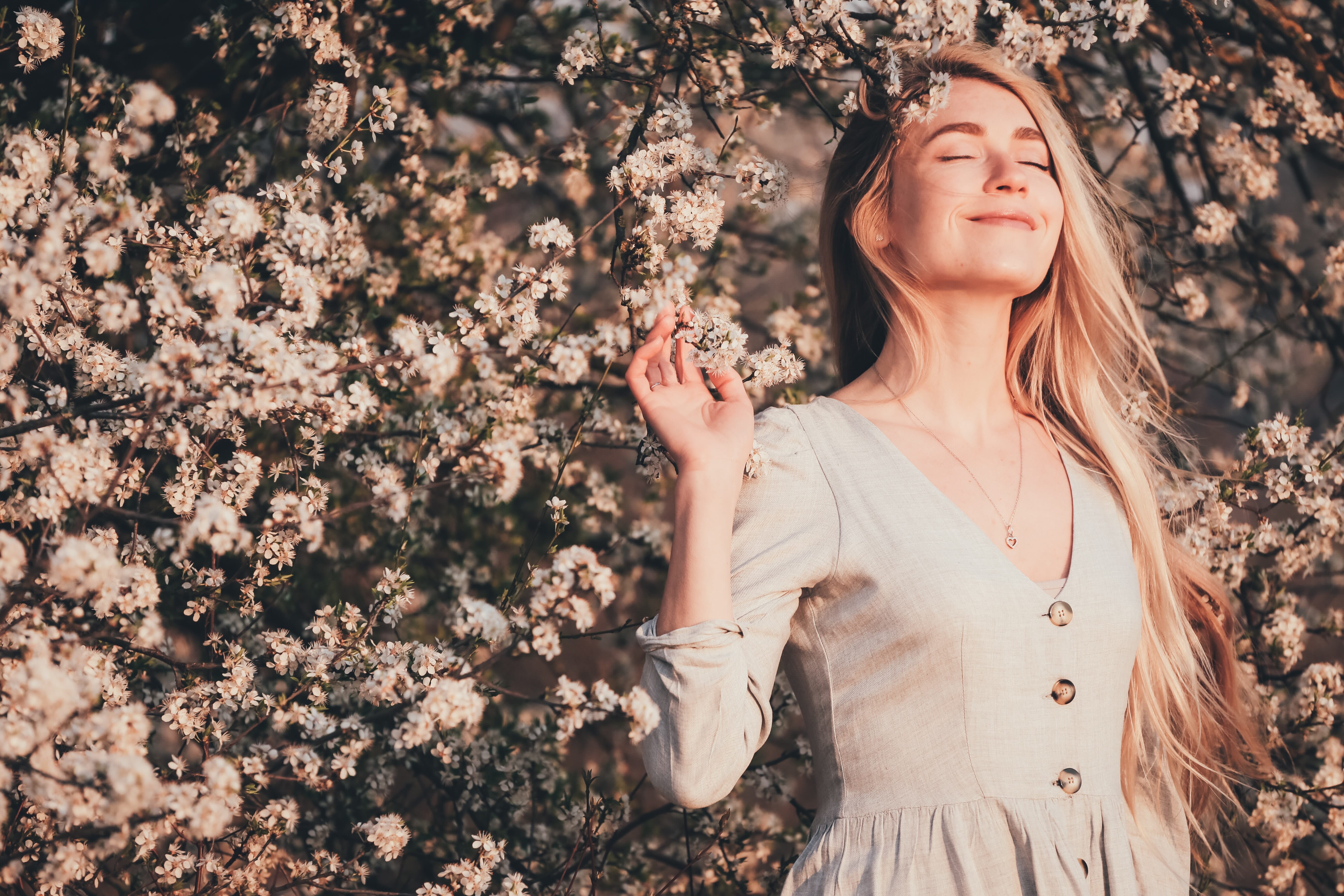
If you don’t get to pick the time of day and you’d prefer to shoot without harsh shadows, you can use flash to fill in the shadows caused by the bright sun. This will even out your image and bring back a lot of color to the flowers!
But remember to soften the flash with a diffuser, or you may accidentally wash out the blossoms completely.
4. Dress Your Client to Work with the Flowers
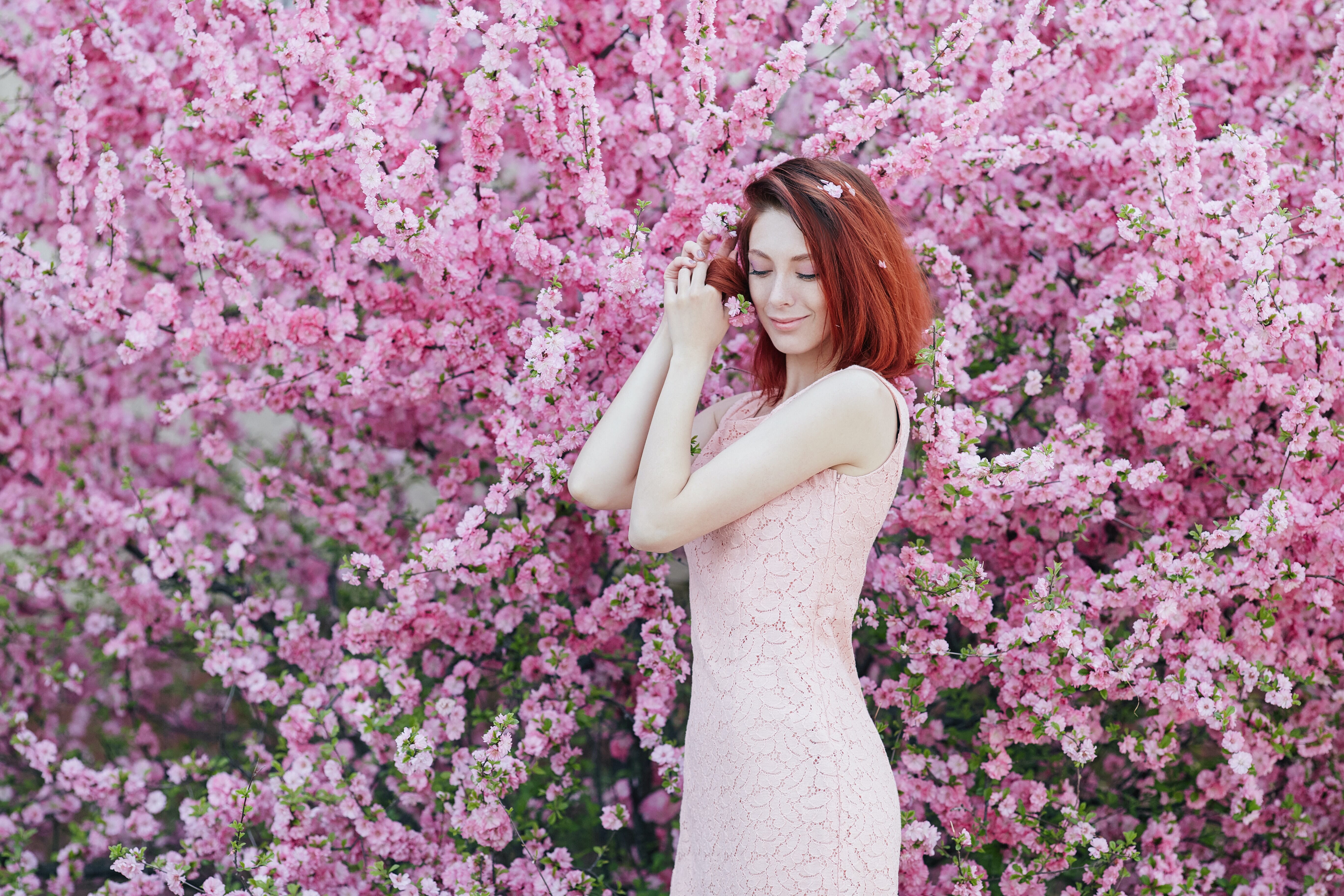
Picking the right color of clothing can make a huge difference. Cherry blossoms tend to look best with more muted or pastel colors. However, you do risk your subject blending in a bit too much with the flowers, so look for clothing items that help them stand out.
On the other hand, traditional Japanese depictions of cherry blossoms tend to show very bold colors (such as red) against the blooms. This contrast can be a striking way to help your subject stand out.
Avoid colors that don’t mesh well with the pink tones of the flowers as this can cause your subject and the cherry blossoms to clash.
5. Choose Trees with Low Branches

The best way to capture subjects against cherry blossoms is with trees whose blossoms grow low! Some cherry blossom trees only have blossoms on the very top, which can be too tall for a lot of photography subjects. Aim to shoot on trees with lower branches so the blossoms can be easily included in your shots.
6. Don’t Let Your Client Harm the Flowers
I don’t believe clients (or photographers) set out to cause harm intentionally, but they can accidentally hurt the flowers. As a photographer shooting in nature, part of your duty is to mitigate the damage that your photoshoots can cause.
Pay careful attention to what your subject is doing. Make sure they don’t harm the blossoms or the tree itself (cherry trees can be fragile). And don’t break branches, pick live flowers off the tree, or otherwise cause harm. Picking up flowers that have naturally fallen to the ground is okay, though!
Cherry Blossom Maternity Session Tips
Pregnancy photoshoots document an exciting time in a family’s life, and cherry blossoms make a gorgeous background.
1. Have Mom Wear Something Flowy
Dresses with flow and movement can create incredibly dramatic shots, especially when combined with cherry blossoms! Since cherry blossoms are soft, delicate, and flow gracefully in the wind, you can mimic this with a flowing maternity dress. Have Mom or an assistant throw the long train of the dress as you take the shot!
2. Use the Flowers to Accentuate the Belly
You can use flowers to lead the viewer’s eye right to the mother’s belly! Arrange your composition so the flowers frame the subject, then shoot on through.
3. Pick Flattering Upright Poses
Because cherry blossom trees stretch up toward the sun, if you can match this movement, you’ll get some great shots. So focus on having Mom do upright poses (as opposed to poses while sitting or lying down).
Cherry Blossom Engagement Photo Tips
Cherry blossoms represent love, so they’re great for engagement photos.
1. Photograph Hands Near the Flowers
Every engagement photoshoot must have at least one shot showing off the engagement ring, so why not make the flowers a big part of this? Move the ring hand over to the flowers and use a shallow depth of field to capture the beautiful diamond in a sea of pink.
2. Use Cherry Blossom Tunnels to Your Advantage
Some of the most famous cherry blossom destinations feature what is known as a blossom tunnel, or an opening within a row of cherry blossom trees. By placing your subject beneath a row of trees, you can let the branches create an archway!
3. Use a Shallow Depth of Field Lens
To ensure the focus remains on the couple, use a shallow depth of field to help the cherry blossoms become part of the shot (you don’t want them to steal the spotlight, after all!).
You’ll get the best results by using a lens featuring a wide maximum aperture; that way, you can create a beautiful shallow depth of field effect!
Cherry Blossom Family Photoshoot Tips
Family portraits are so special. Why not enhance your family portrait sessions with cherry blossoms?
1. Pick Complementary Family Colors
Putting the whole family in matching attire can make your images feel intentional and complete. Look for a color scheme that complements the cherry blossoms! Pastel colors work very nicely.
2. Have Children Play with the Fallen Flowers
Underneath every cherry tree is often a blanket of flowers that have fallen naturally. You can have children throw and play with these fallen flowers to capture the fun feel of spring! Be sure to set a fast shutter speed to freeze the action.
3. Focus on Candid Moments
Some of the most beautiful moments are completely candid, so don’t put your camera away just because the family has stopped posing.
Keep capturing candid moments of the family members as they observe the cherry blossoms, walk through the field of trees, and otherwise enjoy each other’s company.
Cherry Blossom Photography Ideas
Now that you’re fairly well versed in the technical aspects of cherry blossom photography, here are some ideas to inspire your next session!
1. Shoot through the Flowers

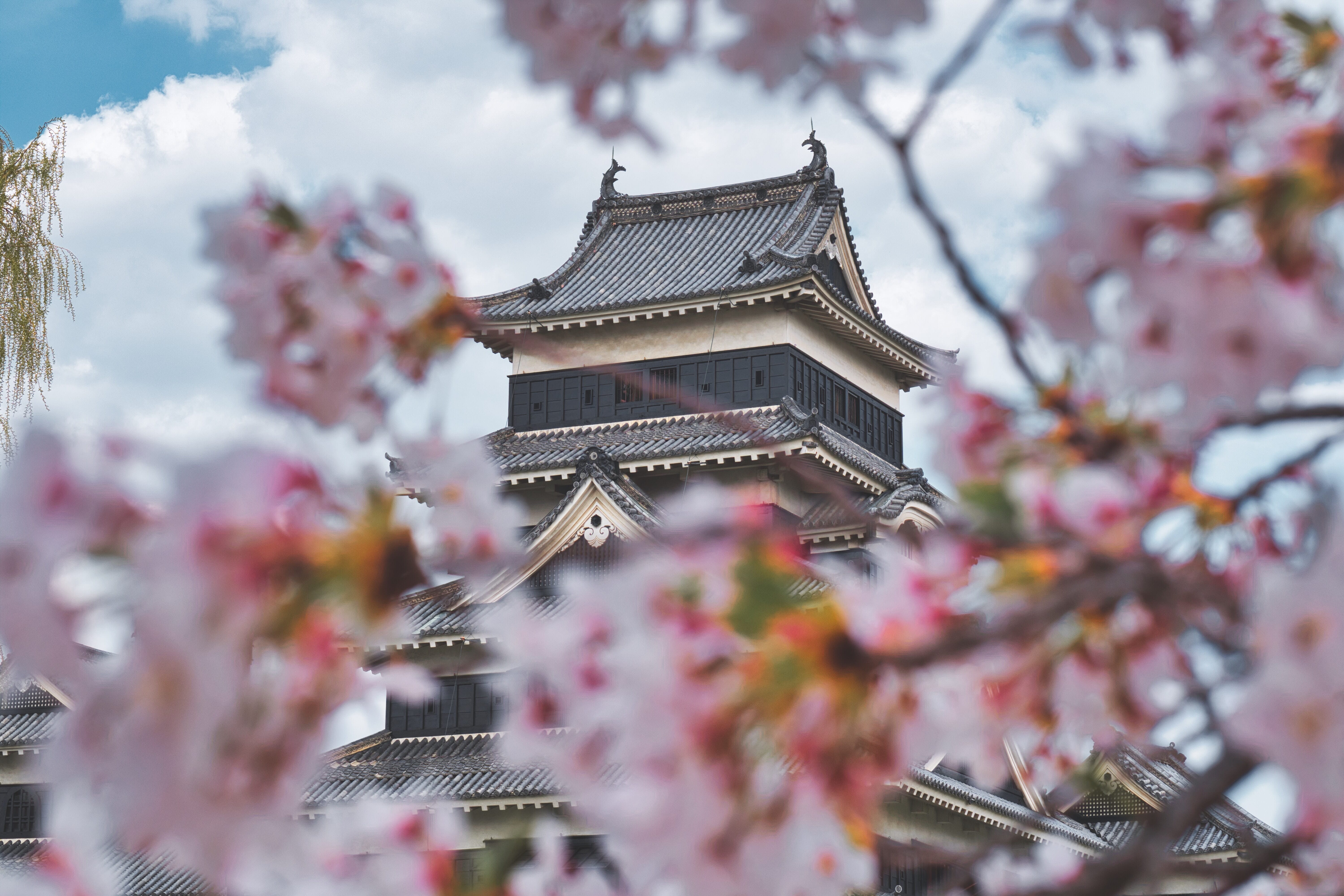
You can use the cherry blossoms as a helpful compositional element! Set your lens to its widest aperture, then use the flowers to frame your subject. The details will melt away, and you’ll be left with an exquisite border.
2. Get Ideas from Traditional Art
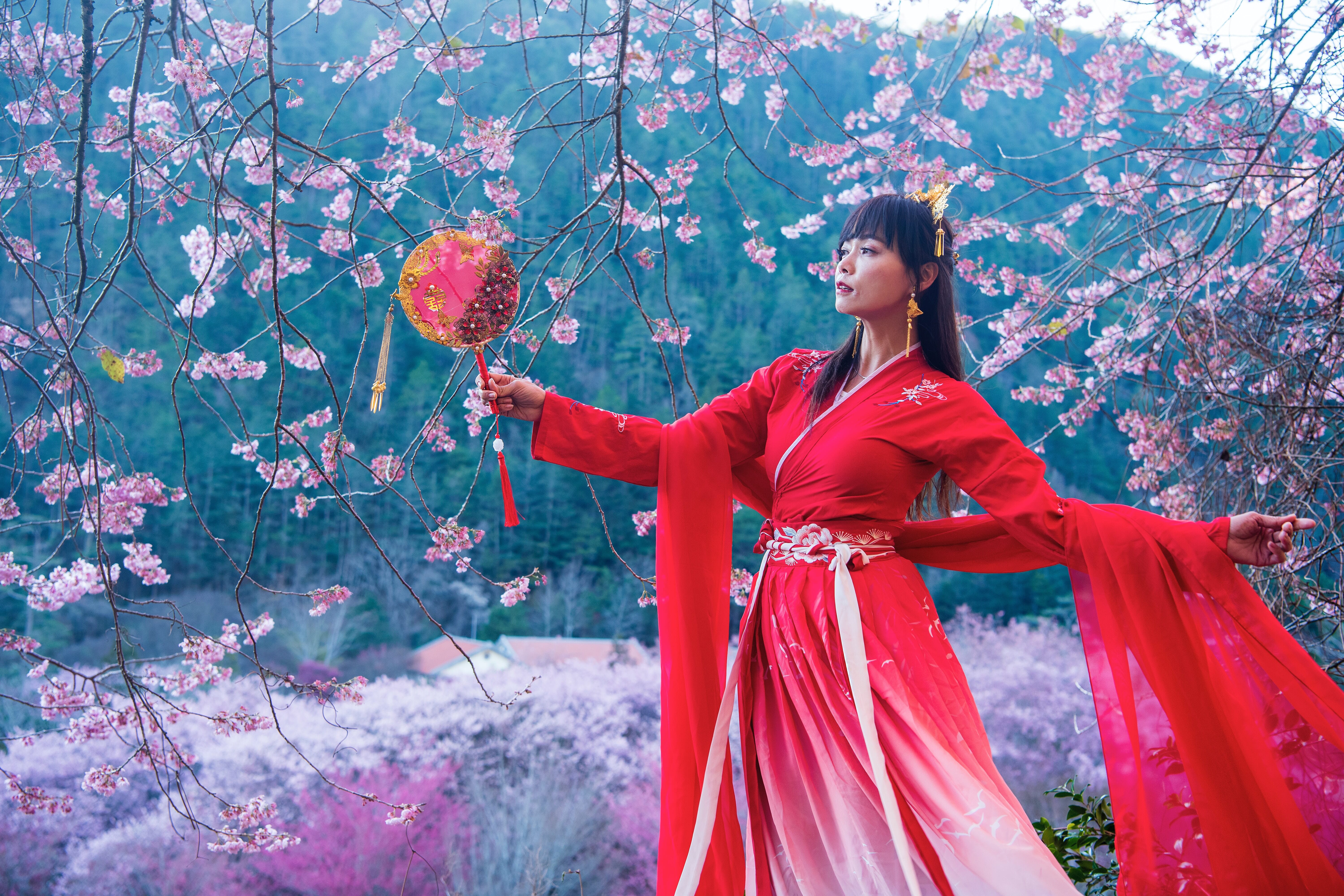
Cherry blossoms are quite prevalent in traditional Japanese art, so why not get inspiration from those beautiful masterpieces? Pay careful attention to the colors, compositions, and concepts. You can gather a lot of great ideas from hand-painted artwork.
And speaking to Japanese locals can offer a lot of insight into the culture surrounding these beautiful trees.
3. Have a Picnic Under the Trees

Cherry blossom flowers create a gorgeous pastel blanket when they are shed. Why not have a picnic under the trees? This can be a fun way to capture portraits and portray the ultimate spring mood.
4. Use Water Reflections

Cherry blossoms tend to be planted near bodies of water such as ponds. This is especially true in Japanese gardens, where water is a very important feature.
Use the gorgeous reflections of the trees in the water to add even more beauty to your image. Reflections can be incredibly captivating!
5. Capture the Love
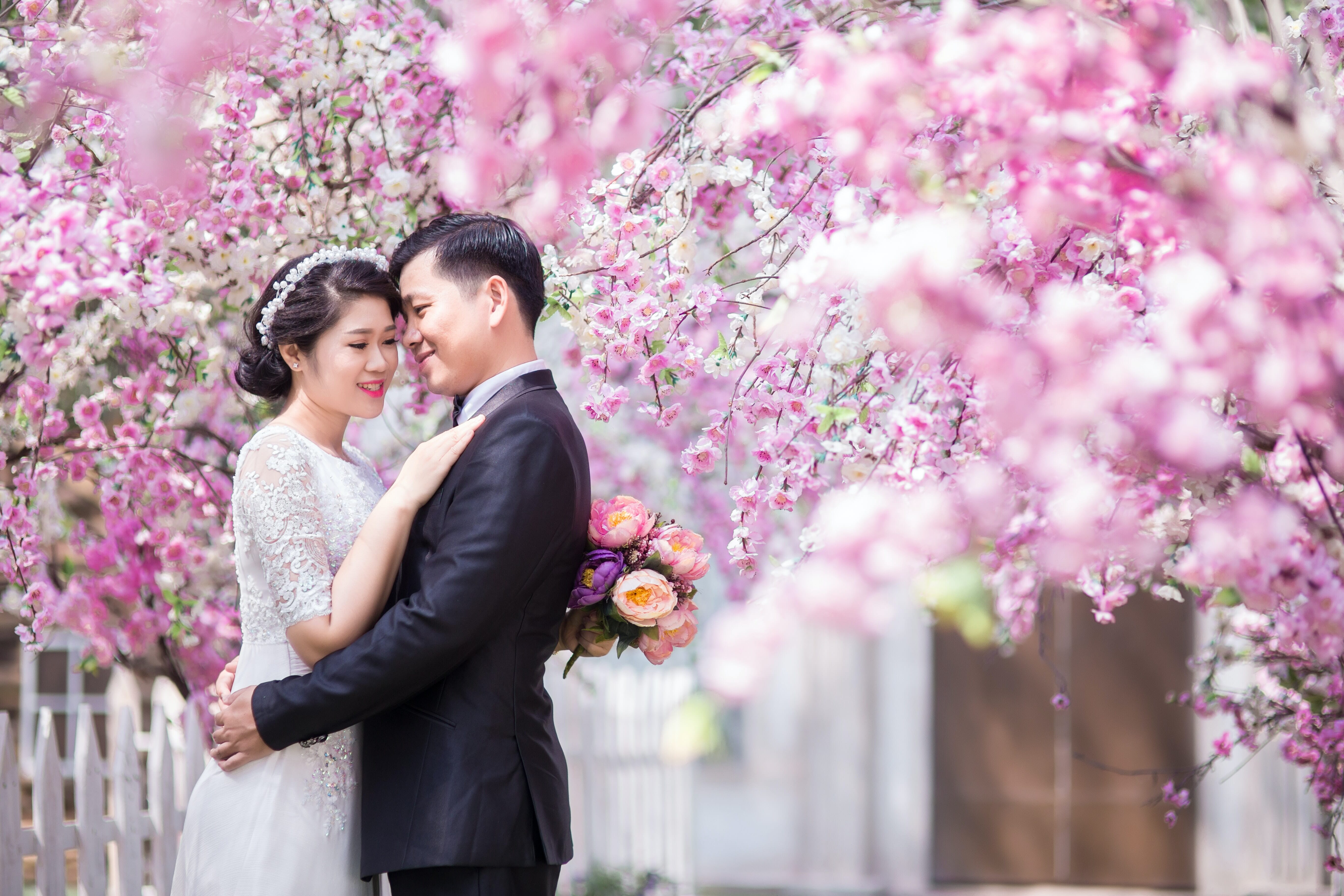
Because of their symbolism and stunning colors, cherry blossoms make great backgrounds for romantic images!
If you happen to have some cherry blossom trees near your wedding venue, be sure to take your couple there for some beautiful painterly images.
Have Fun Taking Stunning Cherry Blossom Photos
There are so many different ways to bring cherry blossoms to life in your photography!
But since cherry blossoms are so fleeting, take advantage when you can. Experiment with all your different options and have a blast!
Disclosure/Disclaimer: As an Amazon Associate, we earn from qualifying purchases. Certain content was provided "as is" from Amazon and is subject to change or removal at any time. Product prices and availability: Amazon prices are updated daily or are accurate as of the date/time indicated and are subject to change. Any price and availability information displayed on Amazon.com at the time of purchase will apply to the purchase of this product.
